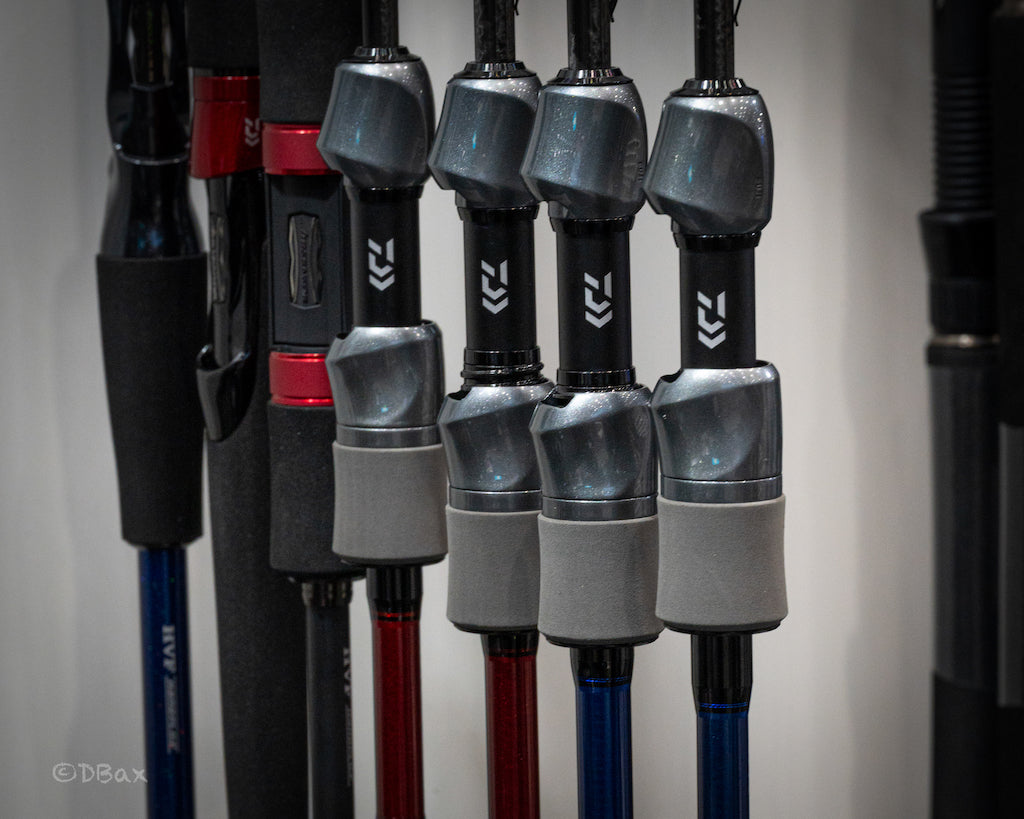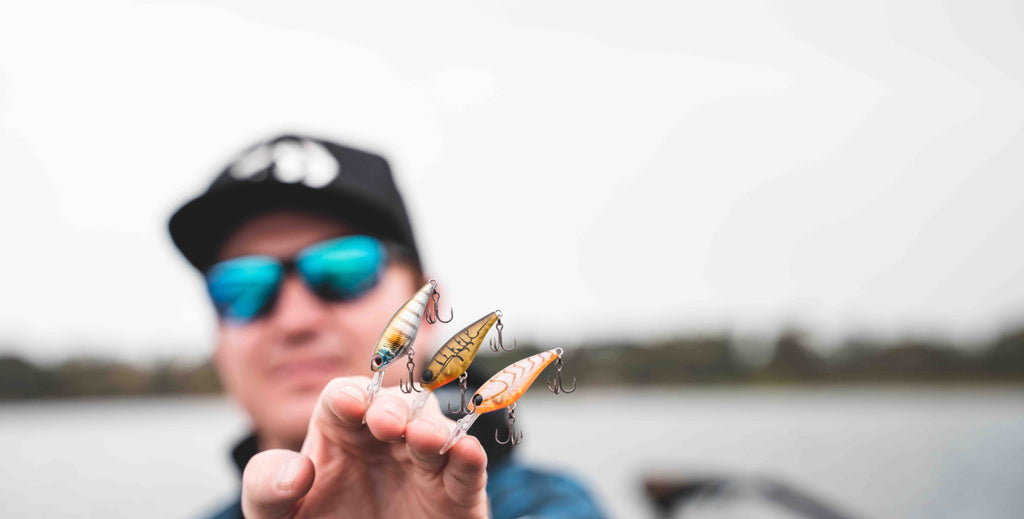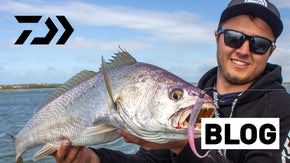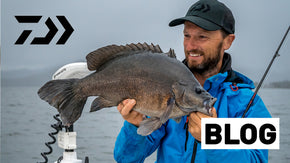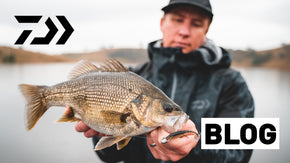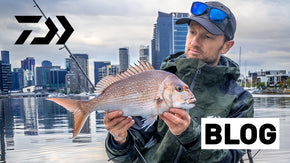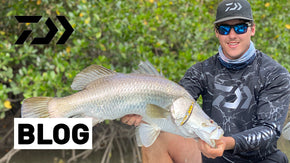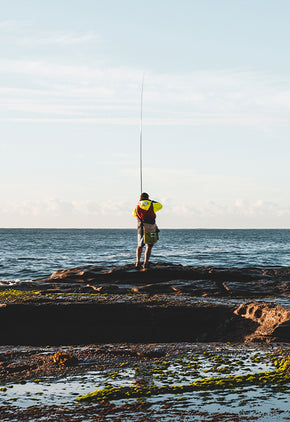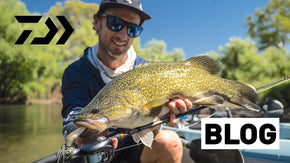Posted 16th November 2022
How to Get Setup for Rock Fishing


By Robert Thornton
Fishing from the ocean rocks is a challenge many Australian anglers choose to take up, and the rewards from this style of fishing can be well worth the effort. Rock fishers, or ‘rock hoppers’, are a different bunch, more akin to surfers or mountain bikers than anglers. This fast-paced activity keeps its participants on their toes and in tune with their surrounds as they simultaneously battle and embrace the elements. Rock fishing is an extreme sport in every sense of the word – it’s equal parts difficult, exciting, rewarding, and at times, dangerous.
Getting into rock fishing requires a different approach to other disciplines, thanks largely to how specialised it is. Getting yourself kitted up for rock hopping is a part of the process, and Daiwa Australia has a great range of specialist gear for this purpose. Learning how to fish in a rapidly shifting environment that is unpredictable to the uninitiated is the other key part of this learning curve. Before we jump into the how-to part of this blog, let’s take a look at what rock fishing is and why people do it.
What is rock Fishing?
When we talk about rock fishing, generally we’re referring to ocean rocks, usually in the form of a headland or promontory jutting out into the ocean. In these areas, there is usually a steady stream of swell that batters and shapes the coastline into jagged formations. In this process, deeper holes are scoured out close to the ledges, and in these turbulent holes a huge variety of fish can be found.
Everything from herbivores eating weed cast adrift by the constant crashing waves to pelagics taking advantage of the turbulence to ambush prey are all fair game for rock hoppers. Most rock anglers prefer to specifically target certain species when they walk out on a ledge, but these targets will often change with the seasons.
There are headlands suitable for rock fishing around most of the country’s coastline, and while the species that inhabit them vary from ledge to ledge, the way anglers approach fishing them is fairly universal. Which brings me to the next point: safety!
 Safety on the Rocks
Safety on the Rocks
To get a good rundown on safety, there’s no better way than to ask someone who’s been doing it for a long time. Alex Bellissimo runs a rock and beach fishing guiding business, Bellissimo Charters, and has been safely guiding people on the rocks for about 16 years.
“I just love the adventure of rock fishing,” he says, “I love how difficult it can be, the challenge, and the anticipation of what you can catch.”
“There is a danger aspect to it as well, which means I have to be fully aware of what’s going on at all times,” he continues, “but this makes me feel alive – when I’m on the rocks I feel more alive than I do with other fishing.”
It’s no secret that a number of deaths over the past century have been attributed to rock fishing. Rock fishing is considered one of the most dangerous recreational activities world-wide, going by statistics. Rock safety cannot be stressed enough, and this is an issue that’s close to me, as I have known people who have lost their lives on the rocks.
In 16 years of guiding, Alex has managed to put countless people onto cracking fish on the rocks, but more importantly he’s made sure that they all return home safely, and this isn’t just luck.
Alex is serious about rock safety. He, like many others, adheres to a simple rule: don’t turn your back on the ocean.
“Many people can become overly focused on the fishing and forget that they need to be watching the ocean,” he says.
This is also why so many rock hoppers don’t fish alone, as having a second set of eyes is a huge help, and is recommended for newcomers.
Another non-negotiable for Alex is to find a high vantage before your session to observe the ocean, and figure out what it’s doing that day.
“I’ll stand there and watch a set of waves and then a lull, and I’ll observe at least 3-4 of those cycles,” Alex explains, “From this I’ll be able to assess the size and direction of the swell – it might take me 15-30 minutes or so.”
“You also want to think about tides as well,” he continues, “you want to know the tidal movements that day, and you want to be looking at things such as rocks that are wet.”
“If it’s not raining, you need to be thinking about why they are wet, so the best thing to do is to stand back and watch.”
“If you notice that it’s just getting a large splash occasionally, it’s probably a safe spot, but if a wave rolls over it, this is probably too dangerous to fish.”
“Basically, if you see any water running off a spot you wish to fish from, don’t fish it until you’ve worked out why there’s water on it!”
Alex likes to compare it to crossing a road. If, for example, you saw a truck 150m away and the speed limit is 100km/h, your experience around roads would tell you that it’s not safe to cross.
 Standing on a ledge, if you saw a large wave forming in the distance, and your knowledge of the swell size and direction of that day told you it would wash over your ledge, you’d move off the ledge until the wave passed. This reinforces why you can’t turn your back on the ocean, and why you must take time before your session to observe the ledge you wish to fish from.
Standing on a ledge, if you saw a large wave forming in the distance, and your knowledge of the swell size and direction of that day told you it would wash over your ledge, you’d move off the ledge until the wave passed. This reinforces why you can’t turn your back on the ocean, and why you must take time before your session to observe the ledge you wish to fish from.
“Even in spots you’re familiar with, conditions could be different the next day, even later the same day!” he says, “so stand back and watch.”
In the event of a wash off, Alex says you need to have a plan.
“Don’t panic, and never try to swim back up onto the rocks,” he explains, “because you’re not trained to do that.”
“If it’s safe, swim in the direction of the swell, and swim around to the sand.”
While you’re observing the ocean before a session, it’s worth identifying the safe areas to climb out should you fall in.
Rock Fishing Baits and Tackle
Gearing up for rock fishing depends on what you wish to chase, however Alex has a few main outfits he uses throughout the year to target the different species that move through the Sydney area.
Rock fishing tackle is usually heavier and longer than normal, and this is because of the terrain you’re fishing around, and also because of the need to haul fish up onto the ledge, usually with the assistance of a wave.
“For pigs [rock blackfish] and wash fishing for snapper I use same outfit,” he explains, “I use Daiwa’s Over There 109MH, with a BG or BG MQ ARK reel in 4000 or 5000.”
On this outfit Alex likes to run 20-30lb J-Braid Grand with fluorocarbon leader of a similar poundage.
It’s a wonderful outfit – light as a feather – so many clients comment on its lightness,” Alex says, “thin as noodle, but very powerful.”
“For heavier stuff like groper and kings, I run a Saltist Hyper Heavy Rock Special, which is rated PE4-6.”
Once again Alex picks from the BG MQ ARK range to accompany this powerful stick.
“The good thing about it is that it has sensitive tip, which is good when fishing for groper,” he says. “A fast action is needed for punching out heavy poppers and metals for larger pelagics, and this thing can do that as well!”
“I’ve had clients catch blue groper up to 13kg on this set up, and kings to 18kg!”
Alex recommends spooling this outfit up with 80-100lb braid, with 50-60lb mono or fluorocarbon trace for groper, or 50-100lb for kings (depending where you’re fishing).
 For his lighter work for species such as luderick, bream and silver trevally, Alex uses an old-school Sandstorm rod, however the updated 21 Sensor Sandstorm series, especially the light 902M model, is a great improvement on its older brother.
For his lighter work for species such as luderick, bream and silver trevally, Alex uses an old-school Sandstorm rod, however the updated 21 Sensor Sandstorm series, especially the light 902M model, is a great improvement on its older brother.
“On my light rig I run a 3000 BG with 8lb braid and an 8-12lb leader,” he explains, “It’s a very floppy rod with a medium action, and if you need to lift a reasonably heavy fish around the kilo mark onto the rocks, you can do that.”
These are Alex’s main set ups, however he also uses a Saltiga Surf 1333H for distance casting baits for snapper, and a Seajigger 325H for casting metal lures at pelagics such as bonito, salmon and smaller kingfish.
If you want to use bait off the rocks, quite often the best baits are those found on the very ledge you wish to fish from. Anglers chasing luderick, groper, rock blackfish and bream will find sea cabbage, cunjevoi and crabs to be very useful local baits. Just be sure to check your local regulations when collecting your own bait.
These same fish will also at times eat dead prawns, beachworms and even bread.
If you want to chase the pelagics that frequent the ledges, Daiwa has a stack of lures that will work. A mixture of topwater lures, soft plastics, metal lures and sinking stickbaits will ensure you have your bases covered if hitting the stones for a luring session.
The Bait Junkie 5 and 7 inch Jerkshads are fantastic searching baits that mimic a lot of common prey species on the rocks. Flicked out wide and worked erratically back through the wash, these lures will turn the heads of hungry predators.
Daiwa’s Shore Spartan series of saltwater lures are perfect for closely imitating this prey as well, and won’t suffer the same damage a plastic will from toothy pelagics. The Break Through, Rough Ride and Power Splash all have the same dimpled design, like the pattern on a golf ball, which helps them to soar through the air.
Anyone looking to chase really big pelagics from the rocks such as the big kingfish in Alex’s stomping ground, or even GTs, mackerel, queenfish or other large pelagics elsewhere, should check out the Saltiga Dive Star. At 220mm long, this floating stickbait can be pelted out a long way, and has an enticing ‘S’ style swimming action to attract the biggest and angriest of ocean predators.
 Non-Fishing Essentials
Non-Fishing Essentials
Alex reckons there’s a few things that anglers shouldn’t go rock fishing without. Those are a lifejacket, some sort of hi-vis with a reflective strip (which may be included with the life jacket), and steel-spiked boots.
Many anglers choose to wear a PFD (personal floatation device), however these are usually auto or manual inflatable. The problem with the former is that it will inflate if you get splashed, which is inevitable on the rocks. Manual inflatables are a good solution, however they’re no good if you are knocked unconscious and you get washed into the water.
It’s worth noting that in some areas in NSW, life jackets are compulsory on the rocks.
“Life jackets that are thin and not too cumbersome to fish are ideal,” Alex explains. “and steel-spiked shoes are a must!”
“Complacency can lead to you going arse over,” he continues, “and on really slippery ground you only need a shin deep wave to make you slide over.”
“People can get seriously injured just by falling over on the rocks.”
Rock On
So, as you can see, rock fishing is not a challenge to be taken up lightly. But if you follow these rules, respect the ocean, and learn as much as you can from those more experienced than yourself, you too can enjoy this high-octane action-packed style of fishing.
Alex Bellissimo is proof that if you prioritise safety over fishing, you can ensure the safety of yourself and those with you. Alex has managed to avoid incident for 16 years, and this is testament to his smart and safe approach to this potentially dangerous activity.
Good luck if you decide to take up the challenge, stay safe, and always look out for your comrades on the rocks.


 Contact Us
Contact Us Blog
Blog About
About
